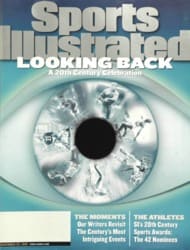
Turning Up The Heat Despite rules changes that were supposed to doom rugged teams like Miami, Pat Riley's crew is off to its hottest start
It's an hour into a routine Miami Heat practice, and coach Pat
Riley is in center Alonzo Mourning's face. "Up! Down! Side!
Side!" Riley barks, commanding Mourning to move the ball as he
demonstrates for Heat players his newest technique, the hover.
Hunkered in a defensive stance, waving his hands furiously to
trace Mourning's ball fakes and jabbing his feet in precisely
choreographed movements, Riley appears for a moment like a
crazed man performing jujitsu on an imaginary foe. "Hovering is
something we came up with because of the new rules. Basically
it's short for Hand Over Ball," Riley explains later. "It's a
form of ball pressure. You can't touch anymore, so you've got to
hover."
Leave it to Riley to find new ways to torture opposing ball
handlers. First with the New York Knicks and then in Miami, he
coaxed his perimeter defenders to the legal limit when applying
a hand check or a forearm to the back. Now, with rules changes
that among other things prohibit contact above the foul line,
Riley is drilling his troops to put their hands in the most
annoying spot allowed--right over the ball, so that a shooter
can't raise it cleanly to take a jump shot or make a pass. "He's
always prepared," guard Dan Majerle says of Riley. "With the new
rules he knew we needed to change the way we played, so he did
something about it."
The 54-year-old Riley has not simply adjusted to the new-look
NBA, he's become its poster boy. Defying the predictions of
those who said the clutch-and-grab Heat would flounder because
of changes designed to create a more wide-open game--including
limiting post-ups to five seconds, cracking down on illegal
screens and physical play off the ball, and liberalizing illegal
defense rules to discourage isolation plays--Riley's team has
prospered. With a 110-92 victory over the Boston Celtics last
Saturday at Miami Arena, the Heat ran its Eastern
Conference-leading record to 8-2, the best start in the
franchise's 12-year history.
Even more surprising, Riley has brought a touch of Showtime to
South Florida with what he calls the Go Game. At week's end the
once offensively challenged Heat was scoring 106.2 points a
game, second highest in the league, and an astonishing average
of 17.2 points more than it scored last season using roughly the
same personnel. With point guard Tim Hardaway pushing the ball
at every opportunity, forward Jamal Mashburn flourishing on the
wings and the fleet Mourning beating opposing centers down the
floor for easy baskets, Miami has cracked the 100-point barrier
in six games. It did so just four times in 50 games last year.
"I see their scores in the paper, and it's remarkable," says
Seattle SuperSonics guard Brent Barry, who spent part of the
'97-98 season with the Heat. "But I'm not real surprised. Pat
Riley did the same thing in L.A."
Riley's rules-driven transformation of the Heat mirrors the
changes going on throughout the NBA, which in recent years has
been plagued by low-scoring games that more closely resembled
WWF Smackdown! than basketball. So far the changes have proved
as effective as a Tim Duncan up-and-under move (chart, page 50).
Last year only one team averaged 100 points or more; through
Sunday 12 were scoring in triple figures this season. True,
there are complaints about excessive whistle-blowing--Charlotte
Hornets forward Anthony Mason recently grumbled that there's
more contact allowed in the WNBA--but the consensus is that the
game has a new vibrancy. Perhaps the best effect of the rules
changes has been the decrease in clear-outs, in which four
players stand around and watch one teammate attempt to make a
basket. "There's so much more movement," says Sonics coach Paul
Westphal. "It's like everybody can breathe again. It's
definitely a more enjoyable game to watch."
Riley's response was certainly ahead of the curve, even though,
as a member of a special NBA committee convened in June to
explore ways to boost scoring, he had argued vehemently against
the revised rules. After their passage, however, he and his
staff immediately caucused on how best to adapt, and by the time
Heat players showed up for voluntary workouts in July, the core
of a new system was in place. Riley revamped the team's
conditioning program, putting less emphasis on weightlifting and
more on footwork and aerobic exercises. On offense the Heat
would seek to take greater advantage of the open-court skills of
such players as Hardaway and Mashburn. On defense it would try
to funnel penetrators inside toward shot blockers like Mourning
and forward P.J. Brown.
Riley also developed specific tactics designed to exploit the
rules changes. Figuring officials would be on the lookout for
hand checks, for example, he drilled his players on driving
aggressively into the midsection of a defender, which would
force him to use his hands to protect himself. On defense Riley
introduced them to hovering, showing them how to get up in the
ball handler's face and place their hands in certain positions,
depending on the location of the ball. As a teaching tool he
even had a chart made with all the proper hand positions shown
on it, like an Arthur Murray dance lesson, only with handprints
instead of shoeprints.
During training camp Riley also unveiled his up-tempo Go Game,
in which all players, not just Hardaway, were encouraged to push
the ball up the floor and swing it to the open man for a quick
shot. (Several other teams that have flourished under the new
rules--the Sonics, the Orlando Magic and the Minnesota
Timberwolves, to name a few--have made a similar adjustment.)
Suddenly big men such as Mourning and Brown were swooping
downcourt to cash in on easy opportunities. Perhaps catching
foes off guard, Miami had outscored opponents 322-225 in the
first quarter through Sunday, including a 67-22 edge in
fast-break points. "You can see it in their faces: They're not
expecting us to run," shooting guard Voshon Lenard says. "They
have this look like they expect us to be a half-court team, and
before you know it they're down 20."
The return of Mashburn, who missed much of the past two seasons
with knee and thumb injuries, has given Miami a versatile and
lethal scoring option. A gifted spot-up shooter, ball handler
and finisher, Mashburn was averaging 20.2 points, 5.7 rebounds
and 3.9 assists per night at week's end, and his productivity
had enabled Riley to start Majerle and use Lenard as a scorer
off the bench. Mourning has continued his MVP-caliber play of a
year ago, while Hardaway has, for now at least, shown that he
has overcome the knee ailments that plagued him last season.
"This is a lot of fun," Hardaway says. "When you run, it makes
you work even harder on the defensive end."
Miami's approach may be different, but it has hardly abandoned
its defense-first mentality. In a 98-93 victory at Philadelphia
last week the Heat held 76ers scoring machine Allen Iverson to
8-of-27 shooting and sealed the victory when Mourning blocked
two straight shots by forward George Lynch on the same
possession, leading to a fast-break basket by Majerle. Miami has
limited its opponents' field goal accuracy to just 42.0%, second
lowest in the NBA, while making life miserable for such big-time
scorers as Iverson, New York's Latrell Sprewell (2 of 14),
Boston's Paul Pierce (4 of 16), the Dallas Mavericks' Michael
Finley (2 of 8) and the Indiana Pacers' Reggie Miller (3 of 10).
"They still play great defense," Sixers coach Larry Brown says.
"They still take pride in that part of the game."
After two straight first-round playoff flameouts to the Knicks,
the Heat was a fragile team heading into this season. It didn't
seem to have the young legs needed to compete under the new
rules, and Riley's hard-driving motivational tactics appeared to
be wearing thin with his veterans. The rules changes, however,
have not only helped Miami remake itself but also rejuvenated
Riley. During the off-season he picked up an option on his
contract to stay on the Miami bench for another five years--a
move that could earn him a reported 20% ownership stake in the
team. "We could not have come back as the same team," Riley
says. "We are different. Our style is different. We are
reenergized."
Whether the Heat can keep up the pace--and whether officials
will continue to call as many fouls--remains to be seen. Some
NBA coaches have already noticed backsliding in the amount of
contact allowed in the low post, a development that could have
Mourning & Co. reverting to their brutish ways. For now, though,
it appears that Riley, the Heat and the league have done more
than survive the transition to a more flowing game. They have
hovered, and soared.
COLOR PHOTO: PHOTOGRAPHS BY BOB ROSATO Fast-breaking the rules Mashburn (with ball) is thriving in Miami's new Go Game, which favors speed over brute strength.
COLOR PHOTO: PHOTOGRAPHS BY BOB ROSATO 'Zo Strong Mourning (22.0 points a game) has helped the Heat average triple figures.
Early Returns
So far the NBA rules changes have had the desired effect of
creating more offense. Scoring is up over each of the past two
seasons, and even though more fouls are being called, the surge
in points is due mainly to an increase in shots from the field
and not from trips to the line.
POINTS PER
SEASON GAMES GAME FG% FGA FTA FOULS TIME
1997-98 1,189 191.1 45.0 159.4 52.6 44.8 2:11
1998-99 725 183.2 43.7 156.4 51.6 44.4 2:14
1999-2000* 149 196.2 44.4 165.9 53.6 48.9 2:16
*Stats through Sunday's games
Source: Elias Sports Bureau

